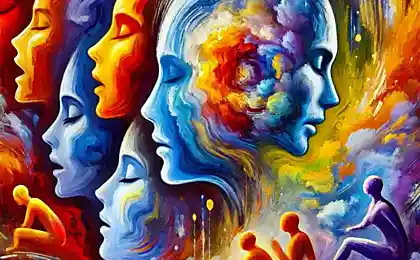319
Classification of emotions - in anticipation of anger
Negative emotions. Many consider them dangerous, harmful, destructive. Only harmful they are not “born”, but become from improper treatment. If you remember, “the dog is biting” is not for nothing. With cockroaches in your head, the same story.

Beetle in a box
Ludwig Wittgenstein once proposed an experiment: Imagine what you and I have in a box. I say, "What's in your box?" and you say, "Beetle." I said, "That's great, I have a bug, too." And if we're not both very interested in insects, we might as well think that our boxes have the same bugs. If we want to see if that’s true, what do we do? Probably say, "I have a big beetle over there, and you do?" - "I have a big one too." It seems that one parameter coincided... But what does "healthy bug" mean? For a person who has ever seen a South American Hercules beetle, and for a person who has never seen anything bigger than a rogue, the concept of what a healthy beetle means will be very different. And it's good that beetles can be pulled out of the box, put next to it and compared. And then find a way to classify them. And what if the beetles were kept only in closed boxes, only their owners could see them, and then not entirely from the corner of the eye - how would we talk about them then? Imagine? Well, there is no need to explain why the description, much less the classification of emotions, is one of the deadliest endeavors of psychology.
Attempts to classify emotions were countless, and most broke about this “bug” problem. In fact, how to classify things that cannot be felt, measured, or separated clearly from each other? And the words with which they are described have many close, but at the same time different meanings, which creates an excellent ground for jokes (“Gogi, do you like tomatoes?” – “Eat yes, and so – nat”), but ugly – for research. However, even on this basis, no certainty can be germinated.
The Wheel of Emotions by Robert the Toiler

The combined efforts of social psychologists like Paul Ekman, ethologists, evolutionary and cognitive psychologists (who are surprisingly good at beautiful and symmetrical diagrams) have created several different classifications of basic emotions. The most successful, in my opinion, is the “wheel of emotions”. Robert the Dodger. The central circle on the wheel is affect, the middle is basic emotion, the outer is some complex emotion. The further away from the center, the less intense the experience is, at the lowest point where the petals close, complete calmness, emotional zero.
So emotions are basic and complex. Complex emotions are obtained from basic, basic - from affective-behavioral reactions to typical situations (or rather, to situations typical of our hominid ancestors).
Alfrid Langle, the author of the existential theory of emotions, defines affect as an immediate feeling caused by an irritant. It does not last long – with the disappearance of the stimulus almost immediately (or after a short “attenuation time”), the affect caused by it disappears. Unlike affect, which is merely a psychic reaction to a stimulus and is not yet personally integrated, emotion is the product of the “refraction” of affect through the prism of subjective values. “Emotion is how a person experiences ... what he or she has taken from a situation,” says Alkfried Langle, “an emotion is not a reaction, but a kind of inner speech.” By “refracting” affect through the prism of basic socio-biological values, we get socio-biological basic emotions. Complex emotions in the slacker scheme are obtained by adding simple ones.
Exercises “Training for Emotions”
Here are some exercises you can do with this table (especially useful for people who have typical emotional states described by the words “bad”, “so-so” and “normal”.)
Emotional arithmetic
Anger + Pre-excitement = FUNNING
Anticipation + Joy = Optimism
Aversion + Anger = Discontent
Fear + Surprise = Confusion
Joy + Trust = Love
Sadness + Disgust = Contempt
AMAZING + SORRY = DOSADA
Trust + Fear = Confidence
Anger + Joy = Triumph
Anticipation + Trust = Hope
Disgust + Anticipation = Cynicism
Fear + Sadness = Despair
Joy + Fear = Risk
Sadness + Anger = Envy
Surprise + disgust = shock
Trust + Surprise = Love
Anger + Trust = Domination
Fear + fear = anxiety
Disgust + Joy = Unhealthy Craving
Fear + Disgust = Guilt
Surprise + Anger = Disturbance
Trust + Sadness = Compassion
Joy + surprise = excitement
Sadness + Anticipation = Pessimism
Emotional Zero = quiescent
Think of this table not as the True and Immutable Dictionary of Emotional Manifestations, but as a simulator for developing emotional competence.
1. Look carefully at the table.
Add to it the missing, in your opinion, options or correct the proposed ones. (For example, why “Trust + Sadness = Compassion”?) I would rather say “sentimentality” or “nostalgia.”
Think about how it differs from your proposal? Why do you think he's more suitable here? Why did the author of the table find another word more appropriate, for what reasons did he put it there, what meaning did he put?
2. Repeat this exercise in a pair or in a group.
You may be surprised that names that seem appropriate to you cause objections and bewilderment in other people, or that someone will insist on offering words that, in your opinion, clearly do not fit. You may understand these words differently. Discuss and try to figure out exactly what the difference is.
3. Remember any emotion that is not in the table.
Now think about which cell to put it in? How is this emotion different from all the others? Intensity? The object you're targeting? Anything else? The exercise process will allow you to better understand the emotional world. So, not only better to understand other people’s emotions, but also to feel your own. As Wittgenstein said, “The boundaries of my language define the boundaries of my world.”
Albert Ellis, the founder of rational-emotional-behavioral therapy, proposed a once simple and convenient formula to describe how this “replication” occurs. A x B = C, where A is the activating event, B is our views and beliefs about the world, and C is the consequences (in our case, a complex emotion). A complex emotion is determined by how we interpret the situation. Some people allow themselves to be crushed by negative emotions, while others do not. And this suggests not so much that they have different physiological reactions, but that they experience these reactions differently. Ellis divides beliefs into rational and irrational. The first is expressed in the form of wishes and preferences: “I like when I succeed in what I do.” The second is in the form of absolute demands: “I must succeed in everything I undertake.” And the same emotion, when multiplied by rational belief, turns out to be unpleasant, but quite bearable, and when multiplied by irrational, torture. Thus, a healthy negative emotion differs from an unhealthy one only by the belief applied to it.
The definition of irrational beliefs
Irrational beliefs can be recognized by a number of common signs (watch the internal dialogue!).
The absolute requirement to yourself: “Everyone should always like me.”
Overgeneralization: “I never succeed.”
Drama: "It's unbearable!" I can't stand it!
The absolute demand for peace: “This should not have happened!” Never!
Failed to pass the report on time – now I will definitely be fired, I will not find another job, there will be no money, in a month I will be thrown out of the apartment ... These things, by the way, like to hang out together.
Guilt is a shame: both guilt and shame stem from disgust and fear of being rejected by the reference group. But if in the case of guilt, disgust is caused by a single act, then shame is the consequence of spreading disgust to the person who did what he did not dare to do.
DOSADA – Disappointment: You are sad that fortune has suddenly turned backwards to you – it is quite a healthy annoyance. But if you think that she had no right to do this to you, and that the world is cruel and criminally malicious, then this is the first step towards depression.
Anxiety – Worrying: It is normal to be anxious in anticipation of frightening events. But if you have convinced yourself that this event is a watershed between potential well-being and the irreversible collapse of all life’s aspirations, then anxiety turns into anxiety.
Envy – Jealousy: sadness and anger at the fact that someone has something that would not prevent you – healthy envy, the engine of achievement. But if you believe that something must be yours alone, then your muscular black hands will strangle the girl. The list of such couples could go on, but I think the basic message is clear: suffering is not the result of emotions, but the mishandling of emotions. Healthy optimism easily becomes unhealthy as soon as a person begins to believe that “good things have to happen to me because they’re good and I, the good one, really, really want them to happen.” And with the money that used to go to insurance, now he buys a book "The Secret..." But that's the subject of another article.
Andrei Bespalov
Source: psyh.ru
Source: /users/1080

Beetle in a box
Ludwig Wittgenstein once proposed an experiment: Imagine what you and I have in a box. I say, "What's in your box?" and you say, "Beetle." I said, "That's great, I have a bug, too." And if we're not both very interested in insects, we might as well think that our boxes have the same bugs. If we want to see if that’s true, what do we do? Probably say, "I have a big beetle over there, and you do?" - "I have a big one too." It seems that one parameter coincided... But what does "healthy bug" mean? For a person who has ever seen a South American Hercules beetle, and for a person who has never seen anything bigger than a rogue, the concept of what a healthy beetle means will be very different. And it's good that beetles can be pulled out of the box, put next to it and compared. And then find a way to classify them. And what if the beetles were kept only in closed boxes, only their owners could see them, and then not entirely from the corner of the eye - how would we talk about them then? Imagine? Well, there is no need to explain why the description, much less the classification of emotions, is one of the deadliest endeavors of psychology.
Attempts to classify emotions were countless, and most broke about this “bug” problem. In fact, how to classify things that cannot be felt, measured, or separated clearly from each other? And the words with which they are described have many close, but at the same time different meanings, which creates an excellent ground for jokes (“Gogi, do you like tomatoes?” – “Eat yes, and so – nat”), but ugly – for research. However, even on this basis, no certainty can be germinated.
The Wheel of Emotions by Robert the Toiler

The combined efforts of social psychologists like Paul Ekman, ethologists, evolutionary and cognitive psychologists (who are surprisingly good at beautiful and symmetrical diagrams) have created several different classifications of basic emotions. The most successful, in my opinion, is the “wheel of emotions”. Robert the Dodger. The central circle on the wheel is affect, the middle is basic emotion, the outer is some complex emotion. The further away from the center, the less intense the experience is, at the lowest point where the petals close, complete calmness, emotional zero.
So emotions are basic and complex. Complex emotions are obtained from basic, basic - from affective-behavioral reactions to typical situations (or rather, to situations typical of our hominid ancestors).
Alfrid Langle, the author of the existential theory of emotions, defines affect as an immediate feeling caused by an irritant. It does not last long – with the disappearance of the stimulus almost immediately (or after a short “attenuation time”), the affect caused by it disappears. Unlike affect, which is merely a psychic reaction to a stimulus and is not yet personally integrated, emotion is the product of the “refraction” of affect through the prism of subjective values. “Emotion is how a person experiences ... what he or she has taken from a situation,” says Alkfried Langle, “an emotion is not a reaction, but a kind of inner speech.” By “refracting” affect through the prism of basic socio-biological values, we get socio-biological basic emotions. Complex emotions in the slacker scheme are obtained by adding simple ones.
Exercises “Training for Emotions”
Here are some exercises you can do with this table (especially useful for people who have typical emotional states described by the words “bad”, “so-so” and “normal”.)
Emotional arithmetic
Anger + Pre-excitement = FUNNING
Anticipation + Joy = Optimism
Aversion + Anger = Discontent
Fear + Surprise = Confusion
Joy + Trust = Love
Sadness + Disgust = Contempt
AMAZING + SORRY = DOSADA
Trust + Fear = Confidence
Anger + Joy = Triumph
Anticipation + Trust = Hope
Disgust + Anticipation = Cynicism
Fear + Sadness = Despair
Joy + Fear = Risk
Sadness + Anger = Envy
Surprise + disgust = shock
Trust + Surprise = Love
Anger + Trust = Domination
Fear + fear = anxiety
Disgust + Joy = Unhealthy Craving
Fear + Disgust = Guilt
Surprise + Anger = Disturbance
Trust + Sadness = Compassion
Joy + surprise = excitement
Sadness + Anticipation = Pessimism
Emotional Zero = quiescent
Think of this table not as the True and Immutable Dictionary of Emotional Manifestations, but as a simulator for developing emotional competence.
1. Look carefully at the table.
Add to it the missing, in your opinion, options or correct the proposed ones. (For example, why “Trust + Sadness = Compassion”?) I would rather say “sentimentality” or “nostalgia.”
Think about how it differs from your proposal? Why do you think he's more suitable here? Why did the author of the table find another word more appropriate, for what reasons did he put it there, what meaning did he put?
2. Repeat this exercise in a pair or in a group.
You may be surprised that names that seem appropriate to you cause objections and bewilderment in other people, or that someone will insist on offering words that, in your opinion, clearly do not fit. You may understand these words differently. Discuss and try to figure out exactly what the difference is.
3. Remember any emotion that is not in the table.
Now think about which cell to put it in? How is this emotion different from all the others? Intensity? The object you're targeting? Anything else? The exercise process will allow you to better understand the emotional world. So, not only better to understand other people’s emotions, but also to feel your own. As Wittgenstein said, “The boundaries of my language define the boundaries of my world.”
Albert Ellis, the founder of rational-emotional-behavioral therapy, proposed a once simple and convenient formula to describe how this “replication” occurs. A x B = C, where A is the activating event, B is our views and beliefs about the world, and C is the consequences (in our case, a complex emotion). A complex emotion is determined by how we interpret the situation. Some people allow themselves to be crushed by negative emotions, while others do not. And this suggests not so much that they have different physiological reactions, but that they experience these reactions differently. Ellis divides beliefs into rational and irrational. The first is expressed in the form of wishes and preferences: “I like when I succeed in what I do.” The second is in the form of absolute demands: “I must succeed in everything I undertake.” And the same emotion, when multiplied by rational belief, turns out to be unpleasant, but quite bearable, and when multiplied by irrational, torture. Thus, a healthy negative emotion differs from an unhealthy one only by the belief applied to it.
The definition of irrational beliefs
Irrational beliefs can be recognized by a number of common signs (watch the internal dialogue!).
The absolute requirement to yourself: “Everyone should always like me.”
Overgeneralization: “I never succeed.”
Drama: "It's unbearable!" I can't stand it!
The absolute demand for peace: “This should not have happened!” Never!
Failed to pass the report on time – now I will definitely be fired, I will not find another job, there will be no money, in a month I will be thrown out of the apartment ... These things, by the way, like to hang out together.
Guilt is a shame: both guilt and shame stem from disgust and fear of being rejected by the reference group. But if in the case of guilt, disgust is caused by a single act, then shame is the consequence of spreading disgust to the person who did what he did not dare to do.
DOSADA – Disappointment: You are sad that fortune has suddenly turned backwards to you – it is quite a healthy annoyance. But if you think that she had no right to do this to you, and that the world is cruel and criminally malicious, then this is the first step towards depression.
Anxiety – Worrying: It is normal to be anxious in anticipation of frightening events. But if you have convinced yourself that this event is a watershed between potential well-being and the irreversible collapse of all life’s aspirations, then anxiety turns into anxiety.
Envy – Jealousy: sadness and anger at the fact that someone has something that would not prevent you – healthy envy, the engine of achievement. But if you believe that something must be yours alone, then your muscular black hands will strangle the girl. The list of such couples could go on, but I think the basic message is clear: suffering is not the result of emotions, but the mishandling of emotions. Healthy optimism easily becomes unhealthy as soon as a person begins to believe that “good things have to happen to me because they’re good and I, the good one, really, really want them to happen.” And with the money that used to go to insurance, now he buys a book "The Secret..." But that's the subject of another article.
Andrei Bespalov
Source: psyh.ru
Source: /users/1080
Features of the human psyche, about which the magicians knew before scientists
Modern environmentally friendly houses - the secrets of their construction























